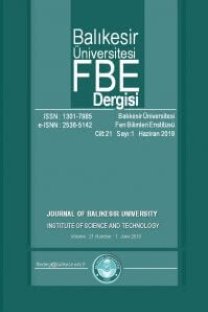Gama radyasyonu ile ışınlanan gallik asitte oluşan radikallerin termal özellikleri
Thermal features of radiation induced radical of gamma irradiated gallic acid
___
- [1] Friedman, M., and Jürgens, H.S.J., Effect of pH on the stability of plant phenolic compounds. Journal of Agricultural and Food Chemistry, 48, 2101-2110 (2000)
- [2] Taniguchi, H., andSchuler, R.H., An ESR study of the dissociation of hydroxyl protons in hydroxycyclohexadienyl radicals. The Journal of Physical Chemistry, 89, 3095-3101 (1985)
- [3] Eslami, A.C., Pasanphan, W., Wagner, B.A., and Buettner, G.R., Free radicals produced by the oxidation of gallic acid: An electron paramagnetic resonance study. Chemistry Central Journal 4, 15-18 (2010)
- [4] Zhao, J., Khan, I.A., and Fronczek, F.R., Gallic Acid. Acta Crystallographica Section E. 67, O316–O317 (2011)
- [5] Melo, R., Leal, J.P., Takács, E., and Wojnárovits, L., Radiolytic degradation of gallic acid and its derivatives in aqueous solution. Journal of Hazardous Materials172, 1185-1192 (2009)
- [6] Melo, R.P.,; Leal, J.P., and Botelho, M.L., Radiolytic degradation mechanism of gallic acid and its end-products. Rapid Communications in Mass Spectrometry 25, 218-222 (2011)
- [7] Tuner H, Bal M. O., and Polat M., Radiation sensitivity and EPR dosimetric potential of gallic acid and its esters, Radiation Physics and Chemistry, 107, 1, 115-120 (2015).
- [8] Tuner, H., EPR spectral investigation of radiation-induced radicals of gallic acid, submited.
- [9] Weil, J.A., Bolton, J.R., and Wertz, J.E., Electron Paramagnetic Resonace, Elementary theory and applications, John Wiley & Sons, New York, p. 481 (1994)
- ISSN: 1301-7985
- Yayın Aralığı: 2
- Başlangıç: 1999
- Yayıncı: Balıkesir Üniversitesi
Zeliha ERDOĞAN, Hatice TORCU KOÇ
Ali GÜL, Semra BENZER, Ömer SAYLAR, Göktuğ GÜL, Mehmet YILMAZ
Tunceli ili merkez ilçesi yapılarındaki ateş bacalarının teknik analizi
Aykut ILGAZ, Mehmet BAYIRLI, Mehmet AYGÖREN
Nano ölçekli plakların serbest titreşimi ve tek katmanlı grafen uygulaması
Kadir MERCAN, Çiğdem DEMİR, Ömer CİVALEK
Dairesel yüzeyli aşma tipi bir dalga enerjisi dönüştürücüde hidrolik verimin deneysel incelenmesi
Mehmet Adil AKGUL, Mehmet Sedat KABDAŞLI
A numerical scheme for continuous population models for single and interacting species
Mustafa GÜLSU, Ayşe ANAPALI, Yalçın ÖZTÜRK
Tek ve etkileşimli türlerin sürekli populasyon modelleri için bir sayısal yöntem
Yalçın ÖZTÜRK, Ayşe ANAPALI, Mustafa GÜLSU
Mardin şehrindeki taştan yapılmış eserlerde görülen bozunmalar
